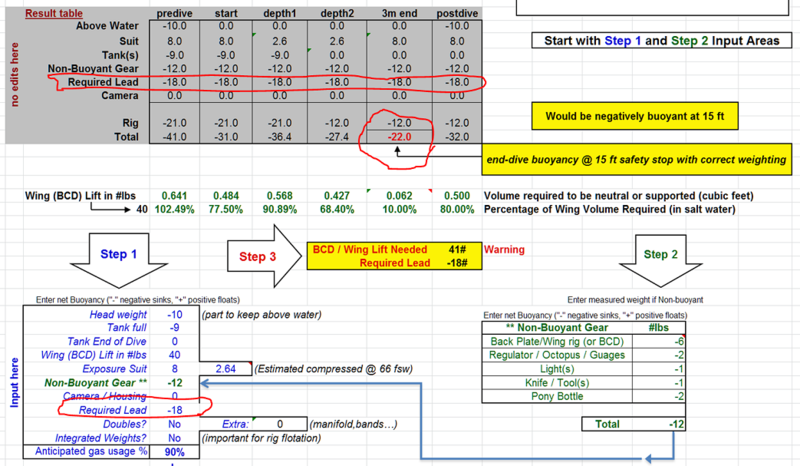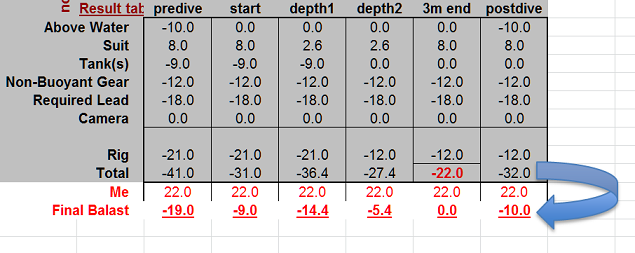The problem is that i've always worn about 26 pounds of lead for diving in jacket style scuba. It was completely unscientific how I got that number, so I decided to dive DEEP into the calculations to see what the heck is going on.
I've read a lot and understand that the three most important factors are:
1. Enough lift for floating the rig solo.
2. Enough lift for compensating for buoyancy changes in suit (failures, compression, etc).
3. Be able to swim up in case of catastrophic wing failure.
The first thing I wanted to figure out was my PERSONAL buoyancy. Both solo, and with my 3/2 XXXL Scubapro Everflex. Yeah... i'm a very large boy. After I EASd from the corps I decided to drink my fitness away and only PT when I'm doing 12 ounce curls. I'm obese and just wanted to get that out of the way. To establish my buoyancy I:
1. Went to a pool in just shorts and found that the lead that made me buoyant on a mid breath was 7 pounds.
2. Then I put the suit in the water and tried to hold it down with weight until it wasn't rising or falling... that was 8 pounds.
3. THEN I put on the suit and confirmed that 15 pounds was buoyant for me. The question then became... how do I calculate the conversion to salt water.
I did some digging and, with some scientific understanding of how displaced water weight works for objects in the water, I went ahead and figured out how much fresh water my fat ass is displacing. Turns out it's 4.5 cubic feet for myself, and about .2 cubic feet for the suit. The conversion then is straight forward. How much does 4.7 cubic feet of salt water weigh (each cubic foot is about 64 pounds)? Here is a summary of my calculations:

It seems like my 15 pounds in fresh water converts to 22.5 pounds in salt water (those numbers on the right should be negative). I then started to create calculations like crazy to try to figure out what weighs what and I found someone else that’s about as crazy as I am and created a calculator for us. I decided on a SS plate (6 pounds), HP120 (-9 full, neutral empty), regulators (2 pounds), handlight and knife (2 pounds), and my H2O EAS2 13cf pony bottle (-2 pounds). I plugged in the numbers into the calculator and found that I could not reach 22 pounds negative as a whole (for me to be neutral) at the stopping point (on the spreadsheet, the column that says "3m end") UNLESS I add 18 pounds of additional weight. Please see the parts I circled in red. Without it, it ends up being only 4 pounds negative in total ballast, which seems like it will make my ass shoot out of the water and high-five the moon.

The question now is on the wing size… I ALMOST purchased a 25 sized wing thinking minimalist DIR… but when I started crunching numbers it seemed like that would be a really really bad idea. Even though the numbers up there are inflated I’m guessing I should subtract the 22 pounds I need for myself and the suit to know what’s actually the real ballast? If that’s the case then I arrive at this…

This means I’ll only need 19 pounds of lift to stay with my head above the water at the start of the dive (predive, that’s the 10 pounds at the top). So… I only need 19 pounds… but then I can’t float the rig by itself…. So a 40 pound wing is almost exact? This just sounds insane to me. Am I doing something wrong? Sorry about the long way around, but I’m sure a fellow newbie can learn a lot from what I posted here in detail, and I know they can learn from any feedback the community can give me.
I've read a lot and understand that the three most important factors are:
1. Enough lift for floating the rig solo.
2. Enough lift for compensating for buoyancy changes in suit (failures, compression, etc).
3. Be able to swim up in case of catastrophic wing failure.
The first thing I wanted to figure out was my PERSONAL buoyancy. Both solo, and with my 3/2 XXXL Scubapro Everflex. Yeah... i'm a very large boy. After I EASd from the corps I decided to drink my fitness away and only PT when I'm doing 12 ounce curls. I'm obese and just wanted to get that out of the way. To establish my buoyancy I:
1. Went to a pool in just shorts and found that the lead that made me buoyant on a mid breath was 7 pounds.
2. Then I put the suit in the water and tried to hold it down with weight until it wasn't rising or falling... that was 8 pounds.
3. THEN I put on the suit and confirmed that 15 pounds was buoyant for me. The question then became... how do I calculate the conversion to salt water.
I did some digging and, with some scientific understanding of how displaced water weight works for objects in the water, I went ahead and figured out how much fresh water my fat ass is displacing. Turns out it's 4.5 cubic feet for myself, and about .2 cubic feet for the suit. The conversion then is straight forward. How much does 4.7 cubic feet of salt water weigh (each cubic foot is about 64 pounds)? Here is a summary of my calculations:

It seems like my 15 pounds in fresh water converts to 22.5 pounds in salt water (those numbers on the right should be negative). I then started to create calculations like crazy to try to figure out what weighs what and I found someone else that’s about as crazy as I am and created a calculator for us. I decided on a SS plate (6 pounds), HP120 (-9 full, neutral empty), regulators (2 pounds), handlight and knife (2 pounds), and my H2O EAS2 13cf pony bottle (-2 pounds). I plugged in the numbers into the calculator and found that I could not reach 22 pounds negative as a whole (for me to be neutral) at the stopping point (on the spreadsheet, the column that says "3m end") UNLESS I add 18 pounds of additional weight. Please see the parts I circled in red. Without it, it ends up being only 4 pounds negative in total ballast, which seems like it will make my ass shoot out of the water and high-five the moon.

The question now is on the wing size… I ALMOST purchased a 25 sized wing thinking minimalist DIR… but when I started crunching numbers it seemed like that would be a really really bad idea. Even though the numbers up there are inflated I’m guessing I should subtract the 22 pounds I need for myself and the suit to know what’s actually the real ballast? If that’s the case then I arrive at this…

This means I’ll only need 19 pounds of lift to stay with my head above the water at the start of the dive (predive, that’s the 10 pounds at the top). So… I only need 19 pounds… but then I can’t float the rig by itself…. So a 40 pound wing is almost exact? This just sounds insane to me. Am I doing something wrong? Sorry about the long way around, but I’m sure a fellow newbie can learn a lot from what I posted here in detail, and I know they can learn from any feedback the community can give me.




